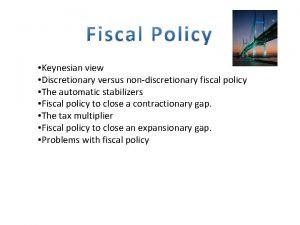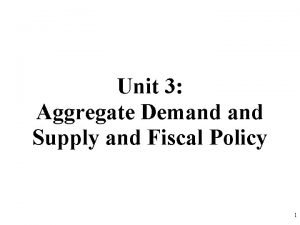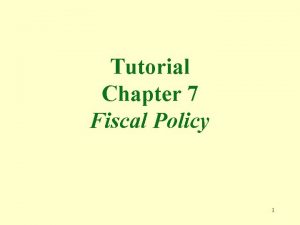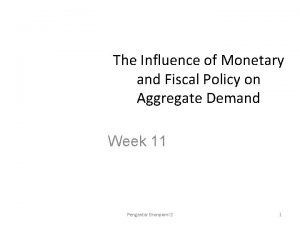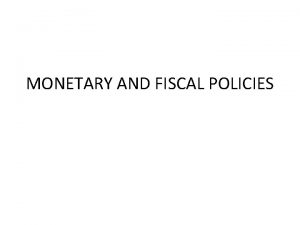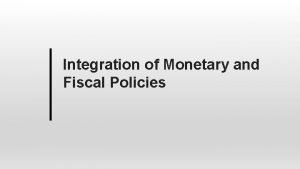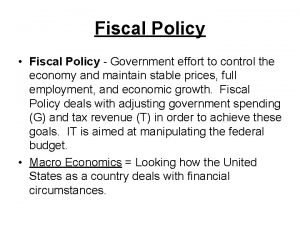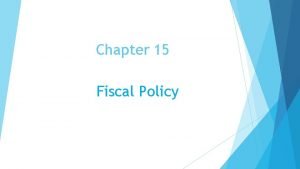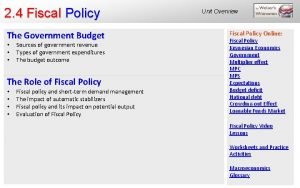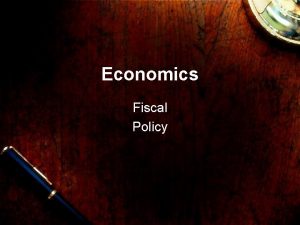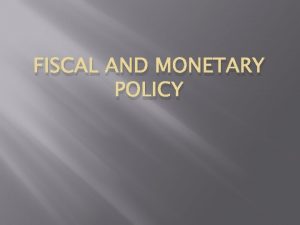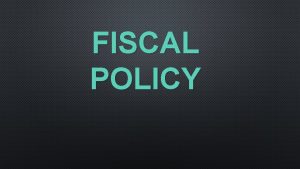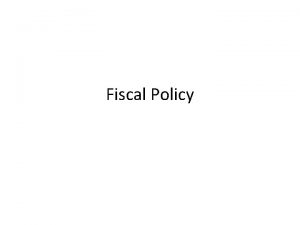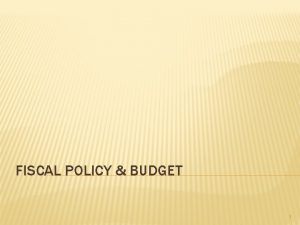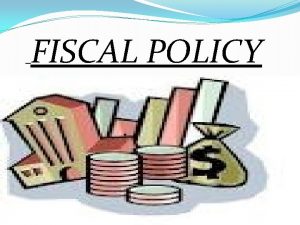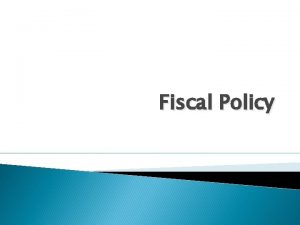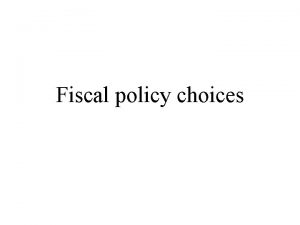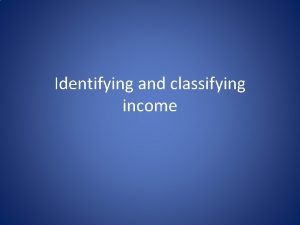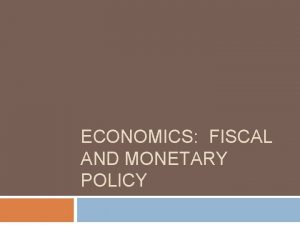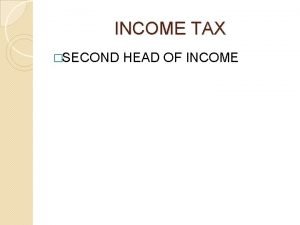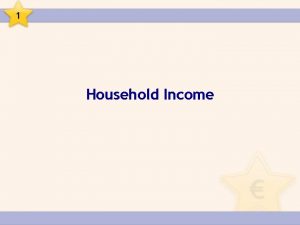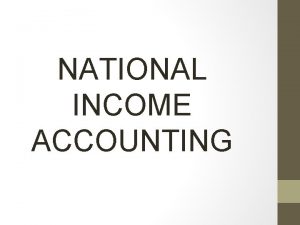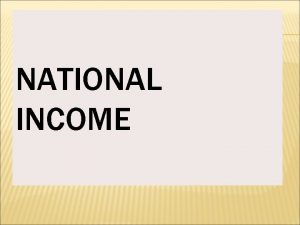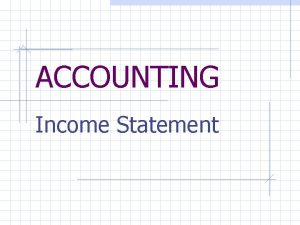Economics I Fiscal and Income Policy Fiscal and




















- Slides: 20

Economics I Fiscal and Income Policy

Fiscal and Income Policy (4 h) • The objective of the first lecture lies in understanding the choice of objectives and instruments of fiscal (budgetary) macroeconomic policy, whose main instrument is the state budget. As income and the expenditure side of the state budget are used to achieve the objectives of economic stabilization policy, i. e. affecting the level of employment and the general price level. The application of fiscal policy is based on the historical development and it is still true that according concrete economic steams there is not a uniform view on the fiscal policy application. • The second lecture will focus on the possibility of the macroeconomic income policy, whose tools can also be used to influence macroeconomic variables. There will be defined the basic objectives and instruments of the income policy, attention will be focused on the measurement and display of inequality in income distribution between different groups of households, on the importance of secondary distribution or redistribution and on role of social policy in achieving the overall objectives of macroeconomic policy.

Content • introduction – defining the goals • fiscal policy, its objectives and instruments • the effects of expansionary and restrictive fiscal policy • state budget deficit and state debt • income policy, its objectives and instruments • measurement of inequality in incomes • primary and secondary distribution of incomes • conclusion – summary, homework

Fiscal policy, its objectives and instruments • fiscal policy – part of the macroeconomic policy • its objective: to influence macroeconomic variables (GDP, general price level P) • the basic tool: the state budget, the revenue and expenditure side • the main revenue of the state budget: taxes (direct vs. indirect) • expenditure side: government purchases of goods and services (G), transfer payments (TR) • the functions of the state budget: allocation, redistribution and stabilization • Taxes – Transfers = Net Taxes; (t. Y + TA) – TR = NT • the state budget can be balanced, with deficit or surplus • state budget deficit and national debt: fiscal imbalance 4

discretionary measures vs. automatic stabilizers There are two basic instruments of fiscal policy: • government purchases (G) • net taxes (NT) Expansionary fiscal policy: Restrictive fiscal policy: G G NT NT 5

Basic relations of the fiscal policy (choice of instruments to influence macroeconomic variables) G= government purchases NT = net taxes price stability AS, AD employment The main instruments of the fiscal policy can influence real product (employment) and price level (in an indirect way – through affecting the AS and AD).

The multiplier effect of government spending and autonomous taxes - comparison (Neokeynesianism) a) multiplier of government spending in a 3 -sectoral (closed), assuming ΔG > 0, increase in G → increase in Y αG = 1 1 – mpc(1 – t) mpc = marginal propensity to consume t = marginal taxation rate b) multiplier of autonomous taxes (TA) – not dependent on disposable income, in a 3 -sectoral (closed) economy, assuming ΔTA < 0, decrease in TA → rise in Y αTA = – mpc 1 – mpc(1 – t) αG > αTA ΔY = αG. ΔG ΔY = αTA. ΔTA 7

The effects of expansionary and restrictive fiscal policy • increase (decrease) in government spending - fiscal expansion (restrictions) has an impact on the demand side of the economy, an increase in G shifts AD curve right, up, reducing G AD curve shifts to the left down • change in tax rate may have an impact on both aggregate demand the aggregate supply (there is a delay in aggregate supply) • tax cuts (permanent) will shift SRAS and LRAS to the right and move to the right and AD, tax increases will cause the opposite shift curves, the overall price level may increase, decrease or remain constant • successful tax reform (reducing the tax burden): AD shift right and shift SRAS and LRAS to the right, the effect is the GDP growth and stable price level • the Laffer curve (supply-side economics) • tax havens (problematic) 8

• the effect of expansionary fiscal policy depends on the choice of instruments and on situation of the economy (whether the GDP is below Y *, or at Y *) • it is necessary to distinguish the effect of fiscal policy in the short and long term. • “crowding out” effect: a decline in private autonomous (mainly investment) expenditure due to rising interest rates. • it is necessary to realize interconnection among final production market and other markets • there is a problem to ensure objectives conformity of macroeconomic policy (fiscal, monetary, income, foreign trade and currency) 9

Expansionary fiscal policy at full resource utilization + crowding out effect P LRAS G SRAS P 3 P 2 P 1 E 3 E 1 Y* E 2 AD 1 AD In the long run full crowding out effect (moving from E 1 to E 3). Real variables in the long term will not change, their nominal values are increased due to the higher price level. Y 10

State budget deficit and state debt – fiscal imbalance • cyclical, structural and real deficit • budget deficit and government debt of the Czech Republic (websites Ministry of Finance, http: //www. mfcr. cz, the Czech Statistical Office, http: //www. czso. cz) • two basic ways to cover the budget deficit: – borrowing on financial markets → crowding out effect – monetization of debt → danger of inflation • debt levels in EU countries are measured by the Maastricht fiscal criteria: – the ratio of public debt to GDP must not exceed 60 % – the ratio of budget deficit to GDP must be no more than 3 % 11

Cyclical, structural and real deficit of the state budget R, E R R = Revenues, dependent on product (income, Y) E = Expenditures, independent on product (income, Y) E´ BDs E BDc BD: Budget Deficit BDC = cyclical deficit BDS = structural deficit Y 1 Y* Y When Y 1 and E' real state budget deficit consists of cyclical and structural components. When Y * and E real state budget deficit consists only of structural component. 12

Income Policy • as a part of the economic stabilization policy • objectives: to influence key macroeconomic variables (the price level and employment) • income policy in order to reduce the average price level can use the following tools: – wage freeze, – statutory limits, – voluntary limits. • other instruments: minimum wage rates setting, regulation of wages in the public sector (and to reduce government spending), regulation of prices for certain goods and services 13

Measurement of inequality in incomes Lorenz Curve (LC) a Gini coefficient (G) Line „a“: absolute equality or „ideal“ Lorenz curve Cumulative % of total income a b 45° absolute inequality curve „b“: real Lorenz curve Cumulative % of households, ranked from the lowest to the highest retirement income 14

Gini coefficient (index) - G A: area under ideal Lorenz curve "a" B: area under the real Lorenz curve "b" A–B G= A The higher the coefficient, the differences in income citizens greater. "G" takes values from 0 to 1 G = 0 …absolute equality G = 1. . . absolute inequality 15

Primary and secondary distribution of incomes • the initial income distribution is the result of market mechanism (all income factors of production: wages, profits, interests and rents) • secondary distribution – a redistribution (through public budgets), resulting in a final income distribution to households • place for social policy - social policy is also part of the macroeconomic policy; there are different approaches and views on social policy – Economists agree that the state should provide assistance in material need, but also draw attention to the generous social programs 16

Literature • FRANK, R. H. , BERNANKE, B. S. Principles of Macroeconomics. 3 rd Edition. Mc. Graw. Hill/Irwin: NY, 2007. ISBN 978 -0 -07 -319397 -7. 561 p. • MANKIW, G. N. Principles of Macroeconomics. 4 th ed. USA: Thomson South. Western, 2007. 583 p. ISBN 978 -0 -324 -23695 -8. • Mc. CONNELL, C. R. , BRUE, S. L. Economics: Principles, Problems, and Policies. 17 th ed. NY: Mc. Graw/Irwin. 716 p. ISBN 978 -0 -07 -312663 -0. • SAMUELSON, P. A. , NORDHAUS, W. D. Economics. 15 th ed. Mc. Graw-Hill, 1995.

Internet sources • The Ministry of Finance of the Czech Republic. The Law on the State Budget. Available at www: http: //www. mfcr. cz • World Bank. Gini index. Available at www: http: //www. worldbank. org • Central Intelligence Agency. Gini index. Available at www: http: //www. cia. gov

Homework Exercise “Fiscal Policy” • Using the AS/AD model draw graphically fiscal restriction in the form of a reduction in transfer payments, draw fiscal expansion in the form of reduction in indirect taxes and fiscal restriction in the form of increased taxes on personal incomes. For all graphs start from the assumption that the economy is on the level of potential output. • On the website of the Ministry of Finance (http: //www. mfcr. cz) find the Law on the State Budget for the current year, the latest, make comments about balance of the state budget, compare expenditures of individual ministries and in case of deficit find out the ways to finance it. • Assume the situation of the economy is in its boom phase (when exceeds potential output), and graph the situation when part of the structural budget deficit is reduced by cyclic budget surplus. • What does a fiscal imbalance mean? And do you know the ways in which the Government can solve it?

Homework Exercise “Income Policy” • Graph the previous and the new Lorenz curve, if you know that the Government has deepened progression in personal income tax. As in this case, discuss change in Gini index. • On the website of the World Bank (http: //www. worldbank. org) find the rank of states by Gini index and put down the first five states with the highest Gini index and the last five states with the lowest Gini index, and find out the last reported Gini index of the Czech Republic.
 Ib economics fiscal policy
Ib economics fiscal policy Macroeconomics lesson 2 activity 45
Macroeconomics lesson 2 activity 45 Aggregate supply shifters
Aggregate supply shifters Unit 3 aggregate demand aggregate supply and fiscal policy
Unit 3 aggregate demand aggregate supply and fiscal policy Nondiscretionary fiscal policy
Nondiscretionary fiscal policy Unit 3 aggregate demand aggregate supply and fiscal policy
Unit 3 aggregate demand aggregate supply and fiscal policy Galloping inflation
Galloping inflation Example fiscal policy
Example fiscal policy Tax multiplier formula
Tax multiplier formula Components of fiscal policy
Components of fiscal policy Crowding out effect of fiscal policy
Crowding out effect of fiscal policy What is liquidity ratio in banking
What is liquidity ratio in banking Tools of fiscal policy
Tools of fiscal policy Fiscal demand side policy
Fiscal demand side policy Fiscal policy to control inflation
Fiscal policy to control inflation Contractionary fiscal policy
Contractionary fiscal policy Instruments of fiscal policy
Instruments of fiscal policy Crowding out definition ap macro
Crowding out definition ap macro Demand side fiscal policy definition
Demand side fiscal policy definition Contractory monetary policy
Contractory monetary policy Crowding out effect of fiscal policy
Crowding out effect of fiscal policy




